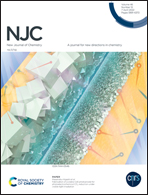Fabrication of a stable CdS photoanode for photoelectrochemical CO2 reduction under visible-light irradiation†
Abstract
Metal sulfides are promising visible-light photocatalysts for CO2 reduction. However, available sulfide photocatalysts are limited because of their instability in aqueous solutions under photoirradiation. In this study, we investigated the fabrication of a stable CdS photoanode for CO2 reduction. The CdS photoanode prepared by the chemical bath deposition method was subjected to N2 calcination, which significantly affected its stability. Calcination up to 300 °C did not significantly change the surface morphology of the CdS photoanode. In contrast, the CdS electrode calcined at 400 °C had a smoother surface, with a lower surface area of the electrode, which consequently reduced the CdS photocorrosion. K2Cd[Fe(CN)6] (particle size ∼10 nm) was densely formed on the CdS surface via photocorrosion, and it effectively scavenged photogenerated holes in CdS and enabled the oxidation of [Fe(CN)6]4− to [Fe(CN)6]3−. Thus, we demonstrated stable CO2 reduction to CO over the CdS photoanode system in an aqueous solution at an applied bias of 0.5 V vs. Ag counter electrode under visible-light irradiation, along with the oxidation of [Fe(CN)6]4− to [Fe(CN)6]3−.



 Please wait while we load your content...
Please wait while we load your content...